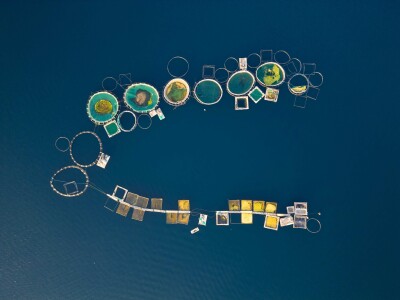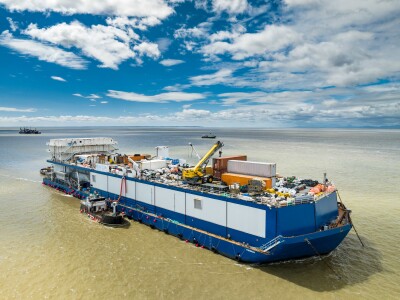Atlantic Blue Crab
High prices lone bright spot as stock woes trigger worst season in 20 years
Poor reproduction appeared to trump a boost in the Chesapeake Bay population of female blue crabs going into 2013. But the worst season in 20 years again had watermen and biologists speculating about predator-prey balances in the troubled estuary.
Maryland's winter dredge survey revealed a big drop that more than halved total crab abundance — the estimate coming out of those counts was down from 765 million in 2012 to 300 million in bay waters. Worse yet, juvenile crabs were barely 20 percent of 2012 numbers, down from 581 million to 111 million.
That propelled Chesapeake prices to new highs — $35 a bushel for females in July, up from $20 a year before, and $85 a bushel for males, compared to $70 the year before. For some watermen, those higher prices made up for poor catches. But other crews were out of work from extreme local scarcity.
Big swings in blue crab populations are nothing new. But they're confounding managers because their efforts to conserve the bay's female crabs seem to be working: Maryland biologists say the female crab population was up 52 percent in the winter trawl samples. Thus, the Chesapeake Bay Stock Assessment Committee said overfishing is not an issue.
So where are the baby crabs going? Blue crabs are notorious cannibals, so crab-on-crab chow-downs may have claimed a lot of juveniles. But many went down the maws of red drum and striped bass, scientists suggest.
Two decades ago the conservation story line was that red drum were being exterminated, thanks to the Cajun cooking craze Louisiana chef Paul Prudhomme ignited with his blackened redfish — ferociously spiced fillets half-incinerated on iron skillets over propane burners.
But red drum are back big time, possibly because warming waters along the East Coast are expanding their range northward. Virginia reported anglers there in 2012 caught 2.5 million red drum, up from 61,330 in 2011. Another downside is shrinkage of the bay's eelgrass beds, critical habitat for young crabs.
That all meant shortages, less work for watermen, big prices early and through the summer season, typically $2 apiece retail for male crabs, and a sustained boost for soft shells. Peak July prices in southern Virginia beach resorts were over $2, up from $1.50 in summer 2012. That held true all along the East Coast as other crab fisheries saw poor results, too.
New Jersey crabbers had a tough year, although crabs already bedded down in fall 2012 appeared to survive the Hurricane Sandy storm surge, winter dredgers reported. Indeed in some places, crabs were the only game in town for weeks after the disaster.
But strangely the off year was experienced all along Southern shores and the Gulf of Mexico. A cold and windy late start to the 2013 season was one factor, but fishermen are also still jittery about the Deepwater Horizon oil disaster's lingering effects.
For processors, that meant prices at least one-third higher and more tightening of their margin, says Bill Sieling, executive director of the Chesapeake Bay Seafood Industries Association.
"We wished we could have had more crabs," Sieling says, but among watermen he knows, the fall-off in catch was compensated by price. "The crabbers made out great even if the catch was down."
For processors, the opposite was true. Already under extreme pressure from cheap imported crabmeat, they could not raise prices much higher for an already expensive product without losing even more customers.
One bright spot was Maryland's aggressive marketing program for Chesapeake seafood, headed by Steve Vilnit of the state Department of Natural Resources. The state's True Blue certification program for restaurants and retailers selling locally caught crabs has recruited more than 150 businesses. "You let your customers know you are serving Maryland crabmeat, and they'll pay a little more," Sieling says. — Kirk Moore
Pacific Shrimp
Near-record West Coast landings keep small fleet in the pink for a fourth year
West Coast shrimpers had yet another taste of the good fishing experienced the previous three years by the time the 2013 season closed on Oct. 31.
The 2013 West Coast harvest total stood at 67.7 million pounds as of Nov. 26, according to Pacific Fisheries Information Network data. Revenues totaled $32.7 million, and the average ex-vessel price was 48 cents per pound. Last year the fleet netted 64.8 million pounds worth $31.9 million; the average ex-vessel price was 49 cents.
"It's been another fantastic year," says Brad Pettinger, executive director of the Oregon Trawl Commission, in Brookings, Ore. "They talk about the good old days; these are the good old days. We have fewer boats. They're catching more shrimp. People are running over areas where they could be catching a ton an hour to get to areas of more than 5,000 pounds an hour."
Oregon's cumulative 2013 harvest was 47.1 million pounds valued at $23.9 million in late November, with an average ex-vessel price of 50 cents, according to PacFIN. In 2012, the 49.1 million pounds Oregon shrimpers harvested was worth $24.6 million, with an average ex-vessel price of 50 cents.
Pettinger says this year's harvest was split among 64 boats. The record 1978 harvest of 56.6 million pounds was divided among more than 275 boats.
Oregon lands the lion's share of the pink shrimp catch. In 2013, Washington added 13.7 million pounds worth $5.8 million. That's up from 9.5 million pounds worth $4.47 million in 2012.
California added 6.87 million pounds valued at $3.02 million in 2013. Those totals improve upon the 6.15 million pounds worth $2.74 million in 2012.
Favorable, cooler ocean temperatures, a lower abundance of hake to gobble up shrimp and a good survival rate for the young shrimp born in 2011 that carried over into the 2013 fishery have once again bolstered the shrimp population.
According to the Oregon Department of Fish and Wildlife's Annual Pink Shrimp Review's summary of the 2012 season, high percentages of holdover shrimp have driven the healthy harvests in the past few years. Two-year-olds comprised 61 percent of the 2012 catch.
And with pricing incentives for larger shrimp in place again in 2013, Bob Hannah, who authors the shrimp review, says the abundance of 1-year-olds may be under-represented in this year's harvest.
That bodes well for another banner 2014 season. Pettinger speculates that good weather near the end of this season sent many boats running farther south, allowing them to target larger shrimp and leave the smaller brood stock alone.
"There's so much of the coast that hasn't even been touched. I think we're looking at another year like this year," says Pettinger of prospects for the 2014 season, which opens in March. "Nothing tells me different."
Hannah, the Oregon Department of Fish and Wildlife's pink shrimp project leader, agrees. "It's always hard to determine great from good, and it's easier to determine good from bad," he says. "The [age] zero shrimp were showing up in a lot of areas during the season, so that's usually good."
As for 2013, the year will go down in history for processors turning out near record volumes with less machinery.
Pettinger reports that the Pacific Seafood plant in Warrenton burned down in early June, taking out four of Oregon's 22 machines. The plant's machinery was capable of processing 50,000 pounds of shrimp daily.
While Pacific Seafood crews worked feverishly to get a temporary plant up and running, remaining plants elsewhere along the coast operated at full strength to sop up the other plant's volume. Deliveries stayed on pace, and the fleet came within 1.5 million pounds of the 2012 harvest. — Charlie Ess






